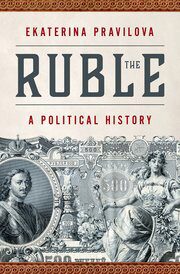By Alex Royt

On March 8, 2022, the Central Bank of Russia (CBR) decided to stop exchanging rubles for foreign currencies. Russia’s invasion of Ukraine the previous month led to sanctions—including the freezing of a majority of CBR reserves— that had made the defense of the ruble’s exchange rate impossible, with the value of the ruble dropping 30% vis-à-vis the dollar. Under the leadership of Elvira Nabiullina, the CBR introduced capital controls, including a ban on sending foreign currency abroad. These measures stabilized the domestic value of the ruble, but the war has transformed the ruble into an inconvertible currency. Inconvertibility has allowed Putin to treat the central bank as his own political tool. By directly supplying the Defense Ministry with cash, the CBR undercuts its reputation as a technocratic institution.
Yet in the context of global history, Russia has never been a bastion for central bank independence, not least because of the frequent demands of war. In fact, the formation of Russia’s first credit bank was followed by the Russo-Turkish War of 1768–1774. Then came the Napoleonic Wars under Alexander I, the Crimean War and Russo-Turkish War under Alexander II, and the Russo-Japanese War and First World War under Nicholas II. Wars have often forced Russia’s Ministry of Finance to impose (either overtly or covertly) capital controls to defend the silver or gold pegs which stabilized the ruble exchange rate in foreign and domestic markets.
Why are Russia’s autocrats able to manipulate money for their personal whims? Ekaterina Pravilova’s timely new book The Ruble: A Political History tells the story of the creation of the ruble by the Tsarist state. In a four-part work covering the period between 1750 and 1924, Pravilova argues that Tsars have always considered money a representation of their own political and economic power. The Ruble: A Political History examines how Tsars and their reformers treated Russia’s currency as a political construct. By examining the meaning of money in various reformist texts, Pravilova shows how the ruble became a material embodiment of the ever-changing Russian idea.
The author continues to forge new paths in the history of the Tsarist economy. Her pathbreaking histories, which include the untranslated yet essential Finances of Empire on the creation of the imperial budget and the prize-winning A Public Empire on the reforms governing Russia’s public property, have cemented her reputation as the leading scholar of Imperial Russian history. The Ruble constitutes another successful entry that situates Russia’s development within broader trends of European history. Pravilova contextualizes reforms so that “without implying some inherent specificity (or pathology) of the Russian state and its society, The Ruble shows how they evolved in the context of Russia’s political, financial, and intellectual relationship with the West and the East” (3).
In a careful reading of Russian archival sources, the first section of the book examines how the modernizing project of the Tsarist state came to focus on the ruble. As early as the late 18th century, liberal reformers such as Mikhail Speransky pushed for a constitution to restrict the power of the autocrat and guarantee the independence of the state bank from the treasury. Yet, from the creation of the Assignat Bank in 1768 to the Great Reforms of 1861, imperial expansion wedded the success of reforms to the whims of the autocrat. By following Russia’s Ministers of Finance, we see how wars resulted in inflation while military expenditure consumed net revenue. Secrecy was instituted regarding the emission of the paper ruble, undermining confidence in the currency’s value. This secrecy worked both ways, as the autocrat was falsely informed that the fluctuating rate of discount for Russia’s bill of exchange was caused by foreign speculators.
While liberal reformers sought to make the ruble a vehicle to constitutional reforms, nationalists consistently kept the ruble inconvertible to stifle reform. The second section alone makes the book worth the price of admission, relating how conservative nationalists saw the ruble as the embodiment of Russia’s uniqueness. This nationalist conception of money came in the form of the “imperial ruble” that, through colonial annexations, reconstituted the Russian empire into a full-fledged ruble zone. Pravilova’s regional case studies reveal how much influence the nationalists had on monetary and foreign policy, such as when monetary authorities in St. Petersburg tried to replace local currencies in Kokand and Bukhara following their annexation in 1868.
The third and fourth sections cover the collapse and resurrection of the ruble zone in the Russian Revolution. While the Minister of Finance Sergei Witte put the Russian Empire on the gold standard in 1897, he was a nationalist with little concern for the political modernization of Russia. As Pravilova notes, his incompetence in financial matters was matched by his conservative distaste for any constitutionalist agendas. Despite this, his careful manipulation of the press made him appear as a modernizer of Russian finance who shored up the State Bank’s gold reserves. The Bolsheviks were, in many ways, similar to Witte. They did not annihilate money but used it to serve their political ends of creating a socialist society. By reconstituting the Soviet Union along the lines of the Russian empire, the Bolsheviks realized the dream of conservative Russian nationalists—recreating the Soviet ruble as an imperial ruble. They even brought back the gold standard, although as a closed economy this return was quite different from the original.
Pravilova’s new book serves as a magisterial example of how political, cultural, and economic history can inform one another. It also serves as a much-needed crash course for understanding the imperial ambitions of the Russian state. Of late, the ruble’s domestic recovery has garnered praise for its chief central banker Nabiullina. While Nabiullina has succeeded in retaining her reputation, many central bankers before her have failed. They have failed precisely during Russia’s many wars.
Alex Royt is a PhD candidate in history at Penn and graduate fellow of the Business, Economic, and Financial History Project.


